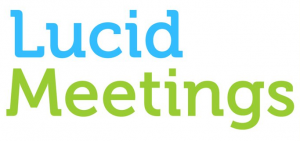Need Help Running Effective Meetings? Lucid Meetings Solves Your Problem
Time to read: 3 minutes


What is Lucid Meetings?
Lucid Meetings was founded to solve the problem of how to hold effective, recurring group meetings. The solution uses at its base the core components of parliamentary procedure, a tried and true method of holding productive meetings. This means that every meeting has an agenda, you can make and capture decisions, take or contribute meeting notes, and then share the results via minutes and action items. The continuity of the group, its goals and conversations, is maintained between meetings ensuring that your next meeting is equally productive.
What makes an effective meeting?
We did considerable research on what constituted an effective meeting and how to run one. What we realized early on was that parliamentary procedure had solved many of these problems over centuries of refinement. In the US that’s Robert’s Rules of Order. To make Lucid Meetings work, we streamlined and distilled the essence of those rules and then translated them to the online environment.
How did you come up with the idea for the product?

How are you using Twilio?
We are building our Twilio integration in several phases, moving forward with each phase once the previous phase is successfully deployed and adopted by our customers. The first phase is basic conference call provisioning and attendee identification. We are taking advantage of Twilio’s features to automatically add attendees to conference calls in progress. If there is more than one meeting on someone’s calendar, we use text-to-speech to provide them with the list of meetings to which they’ve been invited and are currently in session or about to begin.
In later phases we’re looking to more thoroughly integrate the online and telecom experiences by leveraging the text-to-voice, voice-to-text transcription, and SMS features, to name just a few. By using Twilio we can create an online meeting service that is more or less device agnostic: you can join your meeting online, via VOIP, a smartphone, or a normal phone and we’ll make sure the experience is as rich as possible.
What other technologies did you use to transform Lucid Meetings from idea to reality?
Lucid Meetings uses a combination of technologies to support the synchronous in-meeting experience and the before, after and between meeting needs of groups and teams.
For the most part, we’re using standard Web technologies: CSS, JQuery, HTML, etc. Lucid is hosted on Amazon’s AWS framework for ease of deployment and scalability. We have built custom build and deployment processes that allow us to rapidly scale the service as needed to meet demand.
Our biggest challenge was how to support the synchronous in-meeting experience without requiring a plugin or download, as most other real-time meeting solutions do. To solve this, we looked for inspiration to the MMORPG world and found that many of these games are driven by chat-based technologies, such as XMPP. Our in-meeting experience uses a Jabber-based XMPP service to push meeting status and information updates to all attendees in real-time. All attendees are automatically connected to the XMPP chat service when they log into the meeting with their web browser, and all browsers are continuously synchronized with each other to provide a consistent meeting experience.
What are your plans for the future of Lucid Meetings?
So much of our professional lives is spent in meetings, and yet so many of them are unproductive. If we could improve the effectiveness of just a fraction of those meetings, we would consider ourselves successful. And just think what will happen to the GDP!
Related Posts
Related Resources
Twilio Docs
From APIs to SDKs to sample apps
API reference documentation, SDKs, helper libraries, quickstarts, and tutorials for your language and platform.
Resource Center
The latest ebooks, industry reports, and webinars
Learn from customer engagement experts to improve your own communication.
Ahoy
Twilio's developer community hub
Best practices, code samples, and inspiration to build communications and digital engagement experiences.


